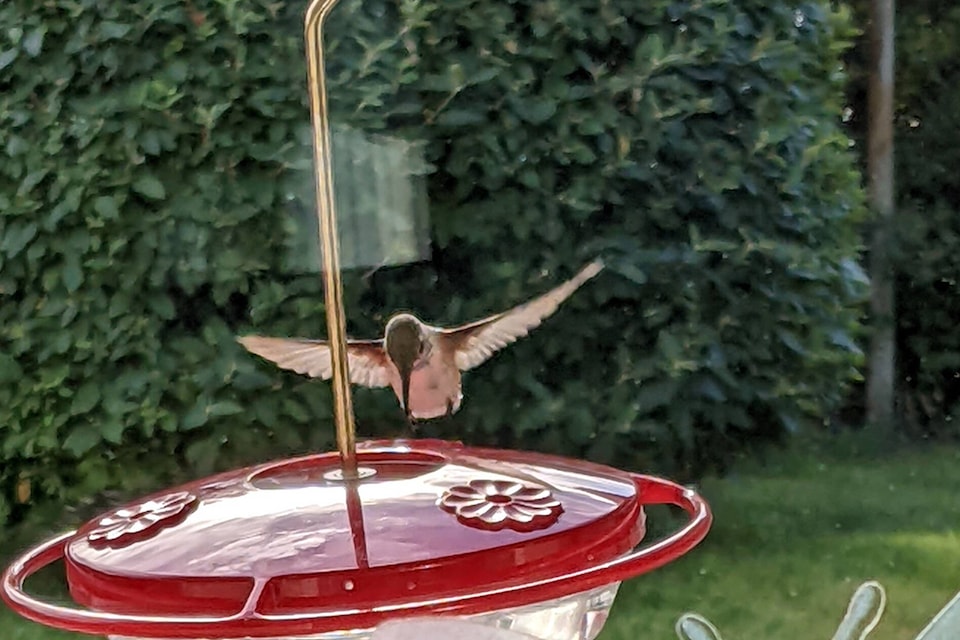Karen Siemens
North Okanagan Naturalists Club
Hopefully we will see a number of the majestic black-chinned, tiny calliope and feisty rufous hummingbirds in our gardens and feeders by mid to late April.
Enjoy the males antics of securing territory and courting a mate as they will depart by late June to early July.
June will see a decline of sightings as the females are busy raising their young and by July we will be delighted to watch the new juvenile hummers as they start to feed on their own from our flowers and feeders.
Did you know that hummingbirds do not just rely on nectar from flowers and feeders for their food. The prime source for proteins, salts and fats are insects. Insects are the main source of food for hummingbird babies. Healthy insects make healthy babies.
Avoid systemic pesticides as they enter the plant and are present in their nectar which the hummingbirds and insects eat. Avoid planting flowers that have been treated with them.
If you are unable to maintain a clean feeder and change food as often as required from April to August then please rely on plants in your garden or hanging baskets to supply nectar.
Hummingbird feeder hints
1) Clean feeders
Clean with HOT water (no soap).
Feeder should be completely dismantled and feeding ports taken apart.
Use a bottle brush for inverted feeders and pipe cleaners for the small holes.
Prior to refilling your feeder take it apart and rinse with hot water.
Twice a week use the brush and pipe cleaners to ensure it’s clean.
Black mould is a death sentence to hummingbirds. If there is any sign of it soak your feeder for one hour in a mixture of one-quarter cup bleach to one gallon of water. Rinse the parts several times in hot water to remove all traces of the bleach.
2) Feeders
Glass feeders are the best. If you buy plastic make sure that it is food grade or UV stabilized. This ensures there is no chemical leakage into the food they eat. Cheap plastic disintegrates and will contaminate the food.
Whether you use inverted feeders or the basin style make sure that the feeder can be completely dismantled for cleaning.
3) Food
The best food for hummingbird feeders is made by you!
Think of your hand, the thumb is sugar and your fingers are water.
One part white sugar to four parts water. Boil water in a pot then add sugar, or you may add boiling water from a kettle to sugar stir till it completely dissolves. Cool to room temperature before filling feeder. You can store this in the fridge for seven days but warm to room temperature before filling feeder.
Never use brown sugar, honey or sugar substitutes as these contain components that will harm the birds.
Do not use red dye (the red on the feeder is all that is needed to attract them). Do not add scent.
4) Changing food
When temperature is 27C or above change everyday.
When temperature is 26 degrees or below change every three days.
Reasons. 1) Heat increases the growth of mould. 2) Every time a hummingbird bill is inserted into the feeder microbes are introduced that feed on the sugar. After three days the food is compromised.
Many people are spending more time in their gardens and if you are xeriscaping you can go online to Okanagan Xeriscape and in their search type ‘hummingbird” and it will give you a list of plants hummingbird friendly.
A few that are popular are bee balm, columbine, foxglove, honeysuckle and Russian sage. Native plants are an excellent choice even if it is only one or two different kinds.
If you do not have a garden then hanging baskets are very attractive to hummingbirds with flowers like salvia, fuchsia, snapdragons, verbena, nasturtium and the ever popular petunia. Keep your hanging baskets out of reach of predators.
For more information on hummingbirds in B.C. go to rpbo.org Rocky Point Bird Observatory Victoria.
Karen Siemens on behalf of North Okanagan Naturalists Club
READ MORE: What’s happening around the North Okanagan
